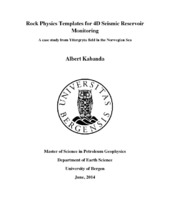Rock Physics Templates for 4D Seismic Reservoir Monitoring: A case study from Yttergryta field in the Norwegian Sea
Master thesis
Permanent lenke
https://hdl.handle.net/1956/8330Utgivelsesdato
2014-06-02Metadata
Vis full innførselSamlinger
- Department of Earth Science [1050]
Sammendrag
Time-lapse 3D seismic which geoscientists often abbreviate to 4D seismic has the potential to monitor changes especially in pore pressure, hydrocarbon and brine saturation in a reservoir due to production or water/gas injection. This is achieved by repeating 3D seismic surveys over some known time interval and the difference between different parameters can be analyzed. This study presents the use of rock physics templates (RPTs) in both reservoir characterization and 4D seismic reservoir monitoring. 4D well-log effect modeling and RPT analysis were used to investigate the power of RPTs towards reservoir characterization and monitoring on the Yttergryta field. Gassmann's fluid substitution modeling was applied on real well-log data to model 4D well-log effects, which included compressional and shear velocity logs, density logs to produce synthetic well-logs representing the reservoir at 25%, 50%, 75% and 100% fluid saturations of brine and gas. Three cases were considered; (1) fluid saturation changes (gas-brine) in Garn formation, (2) change of the gas-water contact in the Ile formation and (3) fluid saturation changes (gas-oil) in the whole reservoir interval from top Garn to base Ile. The Not formation which is between Garn and Ile was left out during fluid substitution. Generally the average Vp/Vs for brine saturated reservoir (around 1.9) was observed to be higher than that of gas (around 1.55-1.72) saturated reservoir cases. The original and fluid substituted logs were used to calculate amplitude versus angle (AVA) synthetics for all the three cases mentioned above using Zoeppritz equations for near angle (5) and far angle (30) degrees, using a zero phase Ricker wavelet of assumed dominant frequency 25 Hz. Seismic amplitude variation on the computed AVA prestack synthetics shown as gathers was found to be successful at showing brine substitution effects. To further appreciate these fluid saturation changes, the differences between the original (base) and the fluid substituted (monitor) AVA synthetics were calculated using the time-lapse module in Hampson-Russell software package. These encouraging results on AVA synthetics suggested that with good quality seismic data from Yttergryta field, it is possible to see a difference in AVA responses between brine and gas filled reservoirs. After this 4D analysis on the computed prestack AVA synthetics, the results were then used in rock physics modeling (static and 4D RPT analysis). In general rock physics and 4D seismic can work together as a link between geologic reservoir parameters (like porosity, clay content, sorting, lithology, saturation) and seismic parameters (like Vp/Vs, density and elastic moduli). This combination can give a broad picture and knowledge about a reservoir in terms of fluid saturation and pressure changes to geoscientists. RPT analysis was performed on both the original and fluid substituted well-log data from Yttergryta field in the Norwegian Sea. Different cross-plots of Vp/Vs versus acoustic impedance (AI) with different rock physics models (RPMs) have been used in the study. The study has demonstrated how RPTs can be used in reservoir characterization and monitoring.
